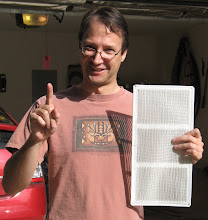I will include numbers for transportation energy use (which I don't typically discuss here), because transportation by car is a giant user of energy; likely at least roughly equivalent in scale to the energy use of my house. This is why there is much discussion of plug-in hybrid cars being used to feed energy to (and take energy from) houses in the future; they might well carry enough battery storage to be significant in the home environment.
You should be able to click to enlarge the table.

From that table, it looks like the attic efficiency work is paying off rather well at 28%, and probably would be paying off spectacularly well had I not muddied the waters by paying for a bunch of roof decking plywood to be replaced in 2009 so that I could get radiant barrier into some areas inaccessible to me from the attic. The cost of that plywood per square foot was roughly 10 times the cost per square foot of the radiant barrier that I ended up putting on it, which is why that rate of return drops so dramatically :( But I was getting the roof replaced at the time; my next shot at getting the sun blocked from that accursed vaulted ceiling would likely have been 15 years later, so I bit the bullet and replaced that plywood with radiant-barrier (and baffle-)covered plywood, improving radiant barrier and ventilation in one fell swoop.
Some might also judge, from that table, that the radiant barrier (completed in 2009) might not pay off as well as the attic ventilation (completed in 2007, which returns a whopping 51% and has already paid for itself). But you might be wrong in that analysis partially because of the plywood cost that's thrown in to the mix. My gut feel is that the payoff of ventilation (plus duct sealing) vs. radiant barrier tilts slightly in the direction of ventilation, but they're both incredibly efficient uses of your money to save energy. And the comfort improvement with radiant barrier is outstanding.
In fact, with rates of returns this high, you literally should be taking a loan at any interest rate less than 20% and applying it to any of these techniques and making money by doing so. But I will not belabor that point; this is a blog about Energy Efficiency, not Making Money... although since these numbers show we can clearly do both at the same time, why aren't we?


No comments:
Post a Comment